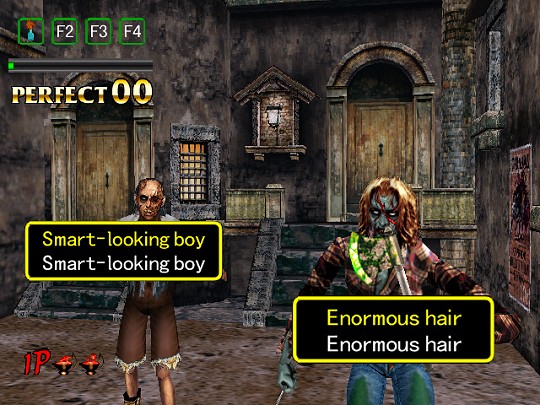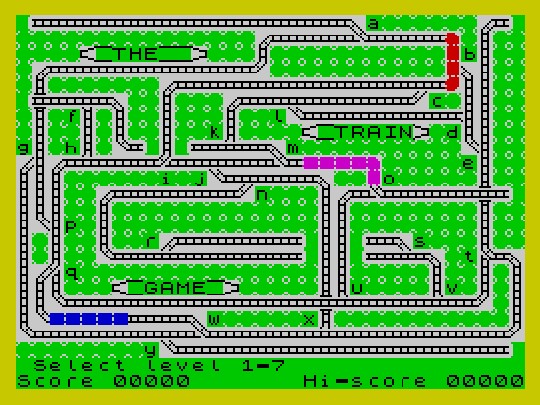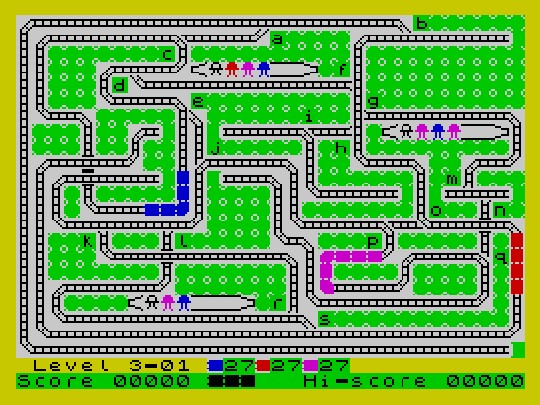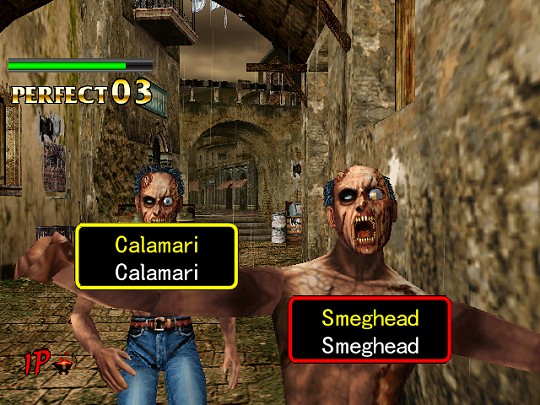|
HAVE YOU MET YOUR
FATHER?
The secret ancestry of classic games.
No.2 - The Typing Of The Dead
|
THIS FEATURE INCLUDES BONUS CONTENT EXCLUSIVE TO WoS SUBSCRIBERS
- CHECK THE EMAIL ADDRESS YOU SIGNED UP WITH. |
One of the most convincing arguments against the status of videogames as a proper artform is their inability to generate genuine emotional reaction - that is, something other than the primal fear of someone going "BOO!" at you, which is all Resident Evil is really doing when a zombie maniac with a chainsaw suddenly comes rushing at you from out of a shack.
Rarely is this failing demonstrated better than in the field of humour. The most common laughs found around videogames are either pity laughs or faintly xenophobic mockings of other cultures (usually the Japanese), and most of the ones played deliberately for comedy are toe-curling embarrassments. Even supposed chortle-fests like The Secret Of Monkey Island struggle to deliver as many good jokes in 30 hours of gameplay as one of the poorer episodes of the later series of Red Dwarf manage in 25 minutes, and usually in the same way, ie by executing a second-rate ripoff of The Hitch-Hiker's Guide To The Galaxy.
There is, however, one exception to this rule.

The words you have to type aren't usually descriptive. We just got lucky here.
Beyond any rational doubt, The Typing Of The Dead is the funniest videogame ever made. It's based on Sega's classic arcade light-gun shooter The House Of The Dead 2, a game which - while cheesy - is also tense, atmospheric and in parts really quite scary. But by the simple expedient of replacing your gun with a keyboard and some random words, it suddenly becomes impossible to be disturbed by even the goriest assaults, or to react with anything other than a warm chuckle as a gruesome monster from under the sea jams a trident between your ribs when you fail to sufficiently quickly type "MAKE ME A HUMBLE APOLOGY" or "TELL ME A FUNNY STORY" at it to deflect its savage attack.
(You can make TTOTD even funnier by playing it with a chum. Angle the screen so that only one of you can see it, and give the other one the keyboard. Then sit back and enjoy an afternoon of one of you frenziedly screaming "URANIUM! EDIBLE SHOES! Q! BACK TO YOU, DAN!" across the room while the other one tries to type off unseen zombies. It's probably not wise to even attempt the game if you were a fan of Vic Reeves' Big Night Out, as you may well actually die of non-sequiteur-related mirth.)
But anyway. This feature isn't here to go on and on about how great The Typing Of The Dead is (which is, amazingly great), but rather to identify its videogaming parentage. And unlikely as it seems, the only game (other than House Of The Dead 2, obviously) to which TTOTD owes a genetic debt is a long-forgotten title from the early days of the Spectrum about points management and maintaining customer satisfaction on a railway network.

The seeming dead ends are actually tunnels - the top right exit loops round to the centre right one.
Microsphere's 1983 classic The Train Game wasn't a smash hit even when it only had about 50 other Speccy games in the whole world to contend with - it was released before most of the Spectrum's games magazines existed, though it did just manage to squeeze into the very first issue of Crash, where it appears rather bizarrely to have scored 75.5%. In an age of the exciting new opportunities offered by the Speccy's high-resolution colour graphics, the barely-beyond-ASCII visuals didn't seize gamers' attention, and even those of us still mired in more medieval times, playing our games on black-and-white bedroom tellies, couldn't enjoy it either because a large part of the gameplay was focused on colour-matching the various trains to their passengers, and telling seven shades of grey apart on a 14-inch portable was a task of distinctly limited fun potential when there was Manic Miner to play.
Which is a terrible shame, as The Train Game is completely brilliant. It's a frantic mix of complex spatial awareness, fast reactions and multiple forward planning as the player tries to keep up to a mind-melting four simultaneous trains running around one of two small railways (there were two different track layouts for the game, one on each side of the tape), collecting colour-coded commuters from three stations before they flew into an explosive rage at being excessively delayed and cost you one of your four lives (which were also forfeited in the event of trains running into closed points, crashing into each other, or having points switched while the train was travelling across them).
The trains couldn't stop (except at stations, and only then for a fixed brief period), couldn't pick up passengers of other colours than their own (except the angry ones who'd turned white, who took precedence over all other passengers and could be collected by any train, but only at the cost of leaving any waiting passengers of the train's own colour behind on the platform), and couldn't be reversed. Each set of points could be set to two positions only, meaning that if you wanted to make a train reach a certain station, you'd often have to route it through a long and complex diversion in order to make it travel in the opposite direction down the line it was currently on. Oh, and sometimes, at the highest of the game's seven difficulty levels, a hurtling runaway goods train would appear and have to be sent into one of the tunnels at the side of the screen to get rid of it. Man, you kids today have it easy.

The red train, which is travelling downwards in this shot, would have to switch points s, l, j, e and d in order to reach its only waiting red passenger, on the top platform. But first it'd have to collect the angry white passenger there, then switch the points at f and go all the way back round again.
But anyway. This feature isn't here to go on and on about how great The Train Game is (which is, amazingly great), but rather to identify its connection to The Typing Of The Dead, and your correspondent is sure that the intelligent, alert readers of WoS have spotted at least the obvious half of it already. Off the top of your reporter's knowledge-filled head, these are the only two videogames ever created (with the exception of the Japan-only TTOTD spinoff Typing Space Harrier, and obviously discounting specifically educational software) in which the primary gameplay skill is intimate familiarity with the layout of the QWERTY keyboard. But there's a bit more to it than that.
Both The Train Game and The Typing Of The Dead, in essence, are not only about typing skill, but about threat management. Most of the time, in either game, you'll have two or three pressing problems to deal with at any given moment, and not only do you have to deal with them all, you'll have to near-instantly assess their relative urgency and deal with them all in the right order. In both games, in fact, it's often necessary to solve one problem purely to be able to solve the second at all. (In TTOTD you have to completely finish typing one zombie's phrase before you can engage the next one, or fight off the projectiles the first one's thrown at you. In TTG you'll often have to route one train through a section of track as another one bears down unstoppably on the same stretch from the opposite direction. In either case, prioritise your actions wrongly and you're buggered.)
The truth of the matter is that if you strip away all the surface irrelevance, TTOTD and TTG are basically the same game. As befits their respective heritages, The Typing Of The Dead is a little less cerebral and more manic, but at the higher difficulty levels The Train Game is if anything the faster-paced of the two, as well as harder and more relentless. Take on Track B at level 7 and you'll be doing well to last much over a minute. TTG actually inspired at least one more-obvious clone, in the form of German developer Kingsoft's superficially very similar Locomotion for the Amiga in 1992 (a fine game in its own right, which replaced the typing-based point-switching with mouse-controlled cursor-pointing), but it's only The Typing Of The Dead that plays the same way as its parent.
Only one of them's funny, though.

Even the undead are angered by Red Dwarf references.
* The Typing Of The Dead was released in the UK on PC budget label Xplosiv for just £4.99 but inexplicably failed to sell, and as a result is now commercially extremely rare. It runs happily on Windows XP via the "Windows 98" setting of Compatibility Mode. There's also a Dreamcast version, which wasn't released in the UK but can be played as a US import.
|

